Launched in early 2024 by Two Notes Audio Engineering, Genome is a plugin and a standalone application for guitarists and bassists. It replaces Two Notes’ historic software -Wall Of Sound- which allowed the use of Two-Notes’ IR technology (“DynIR”) and gave access to its very rich guitar and bass cabinets catalog. Genome is much more than a redesign of Wall Or Sound : in addition to the IR/speaker part that it retains, it also includes modeled amps, profiled amps as well as a set of effects such as overdrives, EQ and other flangers, choruses and phasers… As such, we might be tempted to compare it to the heavyweights plugin market players, among which we find TH-U (Overloud), Amplitube / TONEX (IK Multimedia), Helix Native (Line6), Guitar Rig (Native Instruments) or BIAS FX (Positive Grid). Genome, however, has a slightly different positioning and unique and interesting assets that distinguish it from competing offers….: let’s have a small review.
Two-Notes, Wall Of Sound & Opus
While Genome is a first for Two Notes in the amp modeling domain and in complete guitar sound processing chains, Two Notes is not a newbie in the software field: its reference software – Wall of Sound – has been available for many years, its main functionality being the support of Two-Notes’ in-house technology (“DynIR”) and its impressive catalog of guitar speakers. Wall Of Sound could either be purchased independently of the Two-Notes hardware, or bundled with an IR loader (Cab M/M+) or a load box (Torpedo Reload, Torpedo Captor, etc.) or other Two-Notes hardware…
More recently, Two-Notes has evolved its hardware IR loader (the CAB M+) into a new pedal solution supporting IRs and amplifier modeling, based on a custom technology called TSM (or “Tube Stage Modeling”), named OPUS. The OPUS pedal introduced the support for these modeled amps : approximately ten different amp models can be directly used from the pedal.
With Genome, Two-Notes offers a successor to Wall Of Sound that has been significantly reworked and enhanced: owners and new buyers of Two-Notes hardware benefit from a free Genome license, but it can also be purchased independently of any hardware for around 80 Euros. Genome therefore takes over the features of Wall Of Sound: a load box user (Two-Notes or other) will be able to use it in conjunction with this type of hardware, but it goes much further than its venerable predecessor, both in terms of usable components and processing capacity since it also offers access to amp models and profiles and a whole range of effects…
Introducing Genome
So it’s a plugin for your DAW and also a standalone application -the standalone app was in beta since September 2024 / version 1.5 and was finalized in December 2024 with version 1.6- for Mac and PC. You will need a sound card to route either a guitar DI signal or an amp signal brought back to line level via your favorite load box or even use the line signal from a preamplifier type pedal. Inside your DAW -and as with any plugin- you can position Genome wherever you want in your plugin chain.
Genome supports input signal processing either in stereo or mono mode -a setting that you can configure- and produces a stereo output. The plugin can be configured by using the 10 blocks positioned at the top of the interface: you can assign the components available in the block(s) of your choice and configure your signal path this way. The 10 block route can be split to get two parallel routes (so two times 10 blocks maximum), but you can split your two routes on a smaller number of components and use common components before/after your split/merge points.

In the screenshot above, the overdrive is placed before the split point, then come 4 parallel blocks (a Gemini amp on the “A” lane at the top, and an Albion amp on “B” lane, at the bottom), then there is a merge point followed by a common path for the last 4 blocks.
The graphical interface is refined, intuitive and efficient: we quickly find our bearings and the overall handling of the software is very fast.
In the screenshot below, the upper part of the plugin is reproduced and illustrates the input-output meters of the plugin as well as the configuration of the input signal:

A tuner, a noise gate and a control to adjust the input level are also available on the upper left part of the plugin.
When a block is selected, the central part of the GUI offers a view of the component and allows – of course – to intervene on its configuration. Below, one of the TSM amps, the Gemini:
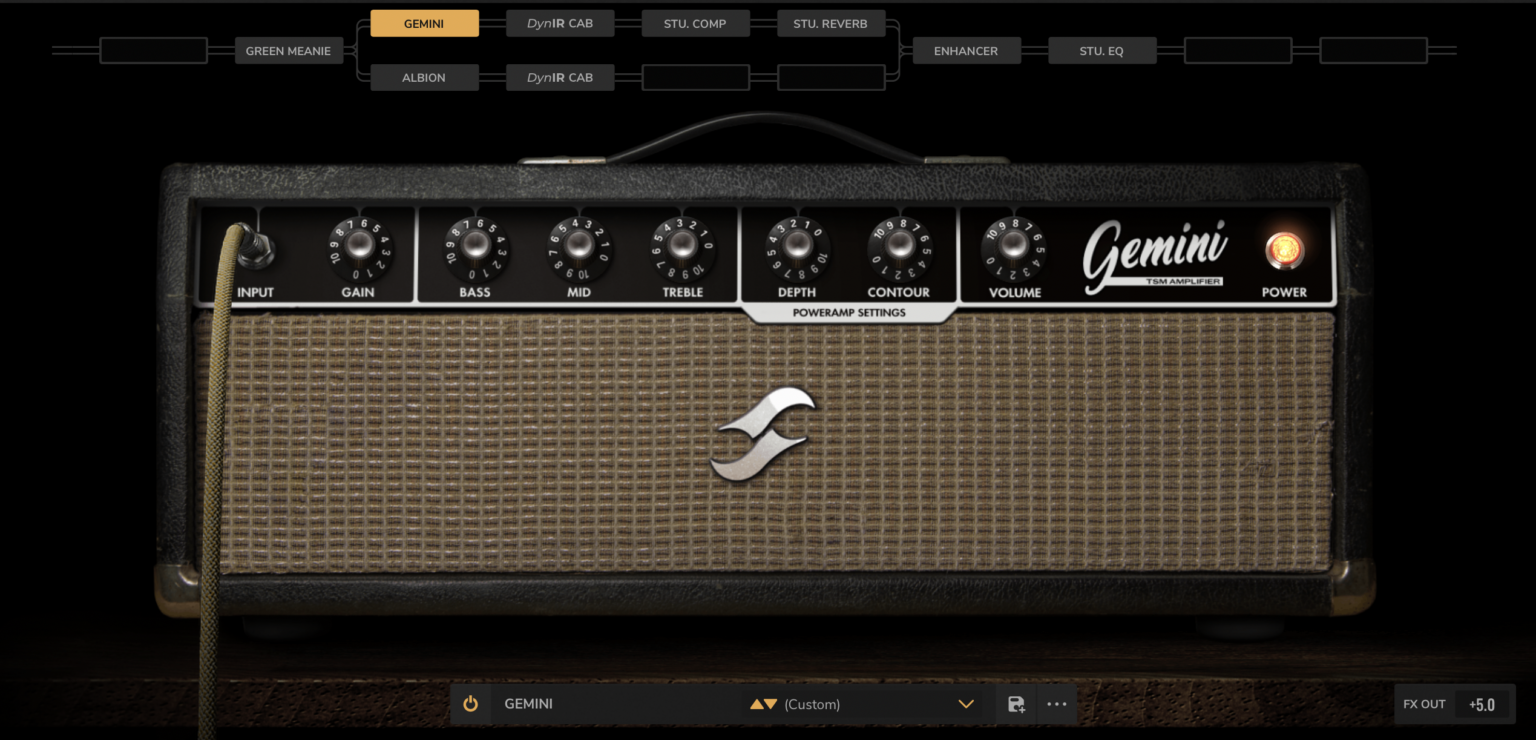
And on the right side, the global output level adjustment and access to the oversampling adjustment, a feature that reduces aliasing phenomena (this requires a relatively powerful CPU, the ULTRA and MAX levels being recommended only for the rendering -bounce- of your guitar tracks):
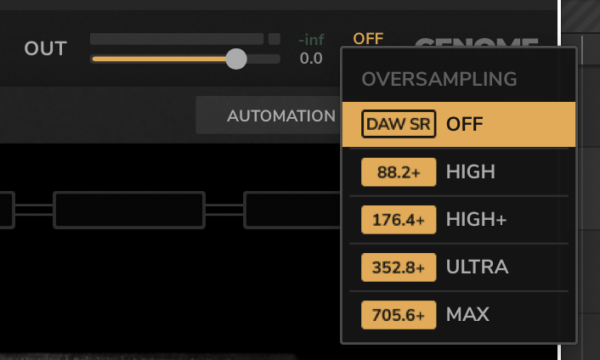
As mentioned previously, you have the possibility to configure two routes (or “lanes” in the Two-Notes documentation) with split and merge points. On the merge point, you have the possibility to configure the resulting signal of the merger with a mixer:

And to finish this introduction, below is a screenshot of the Two-Notes IR loader: this component succeeds Wall Of Sound and provides support for DynIRs (Two-Notes format cabs) and allows you to combine two microphones on a cab.
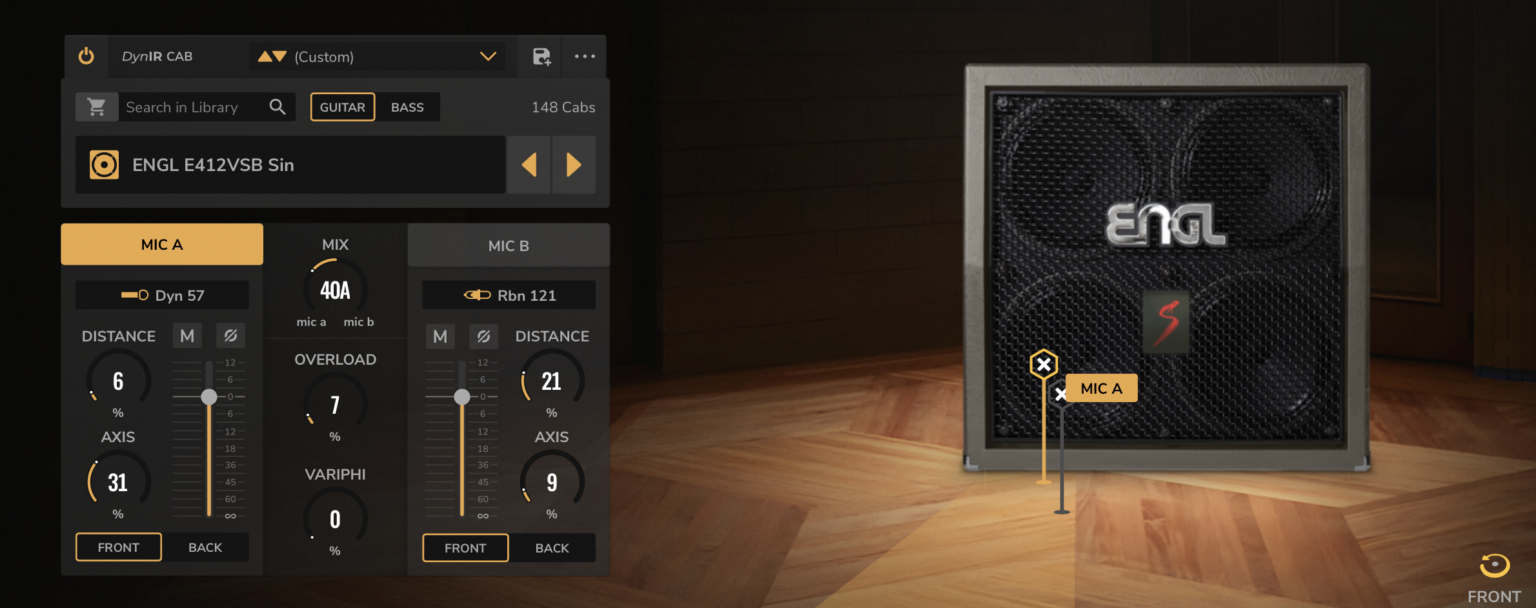
A Wall Of Sound POST FX component is also available: it groups together all the processing options that were available in Wall Of Sound, and it will be useful if you want to obtain a configuration strictly equivalent to one of your previous configurations under WOS.
Available components
Genome embeds a set of standard components -which have evolved and expanded over the course of updates during its first year of existence- and also offers additional -premium- components, to be purchased via the Two-Notes store. You will need to use your Two-Notes account to activate Genome: this allows you to activate and get access to your DynIRs cabinets but will also allow the activation of these premium components.
Genome comes with the following set of components:
- 8 drives/boosts/fuzz
- 12 TSM amps (amps modeled with Two-Notes technology)
- 1 TSM power amp (4 types of tubes)
- 1 CODEX component to load the NAM, AIDA-X and Proteus models
- 2 IR loaders: one main one for the Two-Notes Cabs, the other one for the standard IRs (.wav)
- 3 delays
- 3 dynamic management effects (compressor, volume, noise gate)
- 3 equalizers (bass, guitar, “studio” equalizer)
- 2 enhancers
- 1 wah effect
- 7 modulation effects (flanger, chorus, tremolo, phaser,…)
- 1 reverb
- 1 twin-tracker effect (double tracking/spatialization effect)
Premium components can be selected for testing and audition (audio is cut every n seconds), you will easily spot them as they are preceded by a small “basket” icon:

A similar system is available for Two-Notes cabs inside the “DynIR Cab” component: you can thus audition cabs before purchasing them (this system was also present under Wall Of Sound).
TSM amps
These amps are modeled by Two-Notes and they offer the controls that are classically found in this type of approach: gain, tone stack (bass, mids, treble), master or volume, depth and contour. These last two settings allow you to adjust the power amplification part. In this area, Two-Notes takes up the approach and components already used in Wall Of Sound with a similar power amp section: choice of tubes (6L6, KT88, EL34, EL84), triode or pentode, etc. This section is accessible on many TSM amps under the “POWERAMPS SETTINGS” banner.
Below is a screenshot of the “FlatBack” amp with the power amp pane displayed:
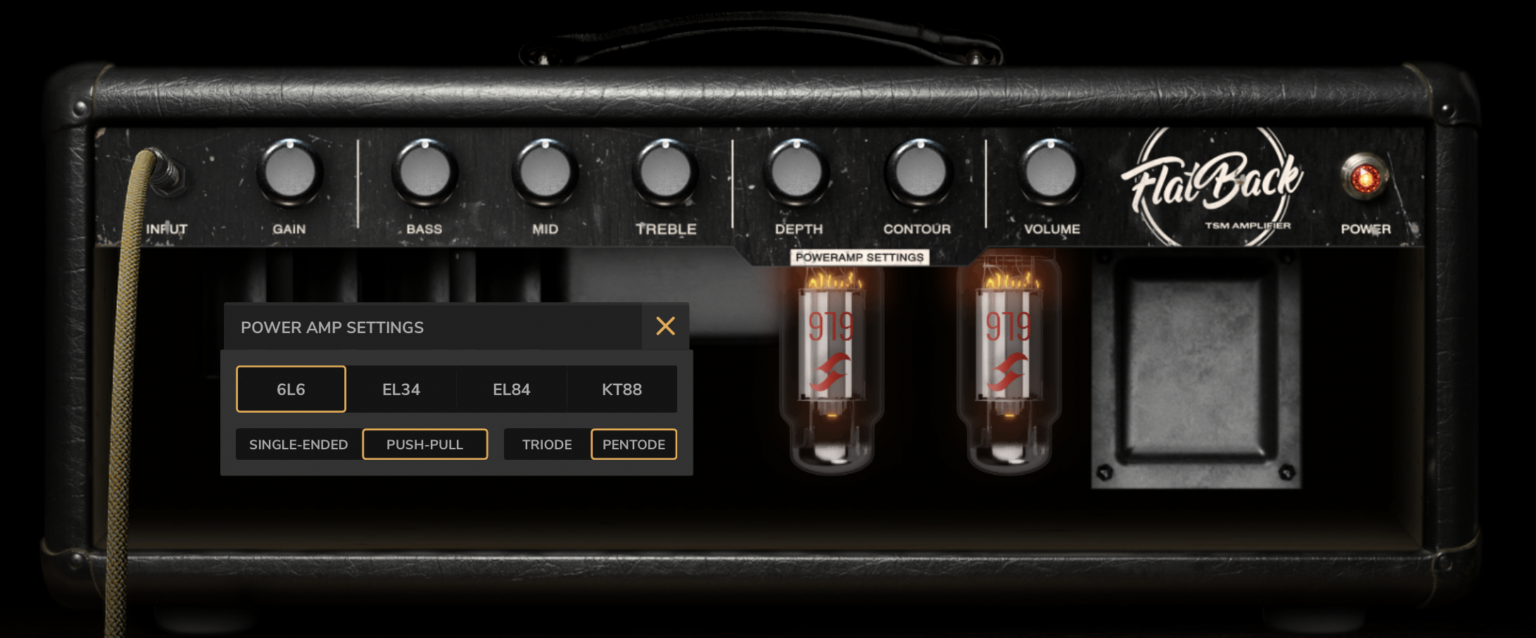
The amps available (in V1.5+) are as follows:
- Albion: a Marshall-type amp
- Aviator: bass amp, modern sound
- Calibro 73, TSM-AI (proprietary AI capture), based on a Fender Bassman
- Eldorado: inspired by a Soldano
- FlatBack: inspired by a Mesa Rectifier
- FaltBack Five: inspired by a Mesa (Mark V?)
- Foundry Bass: bass amp
- Foundry Guitar: clean amp inspired by a Fender
- Foxy: Vox-type amp
- Gemini: Californian-style clean (BassMan??)
- Nifty 50: 5150-type amp
- Peggy: bass amp
- PVH50 TSM-Ai (proprietary AI capture): 5150-type amp
- Tanger: amp inspired by an Orange amp
The simulations are well made and sound quite good and can be configured to get very usable sounds but the possibilities offered by CODEX in this area seemed much more interesting to me (see further down in this review).
Also available is a pure power amp, the “TSM PowerAmp”: it will be useful if you route a pedal or a preamplifier (for example a Synergy preamplifier or the preamp of an amp via FX Send) to add a coloration to your sound and obtain a 6L6, EL34, KT88 rendering…
IR loaders
Two loaders are offered in Genome: a standard loader and the Two-Notes Cab loader. The standard loader allows you to load and mix two IRs, and offers the classic options of phase inversion, mute, but also the possibility of adjusting the phase or adding distortion to the IR:
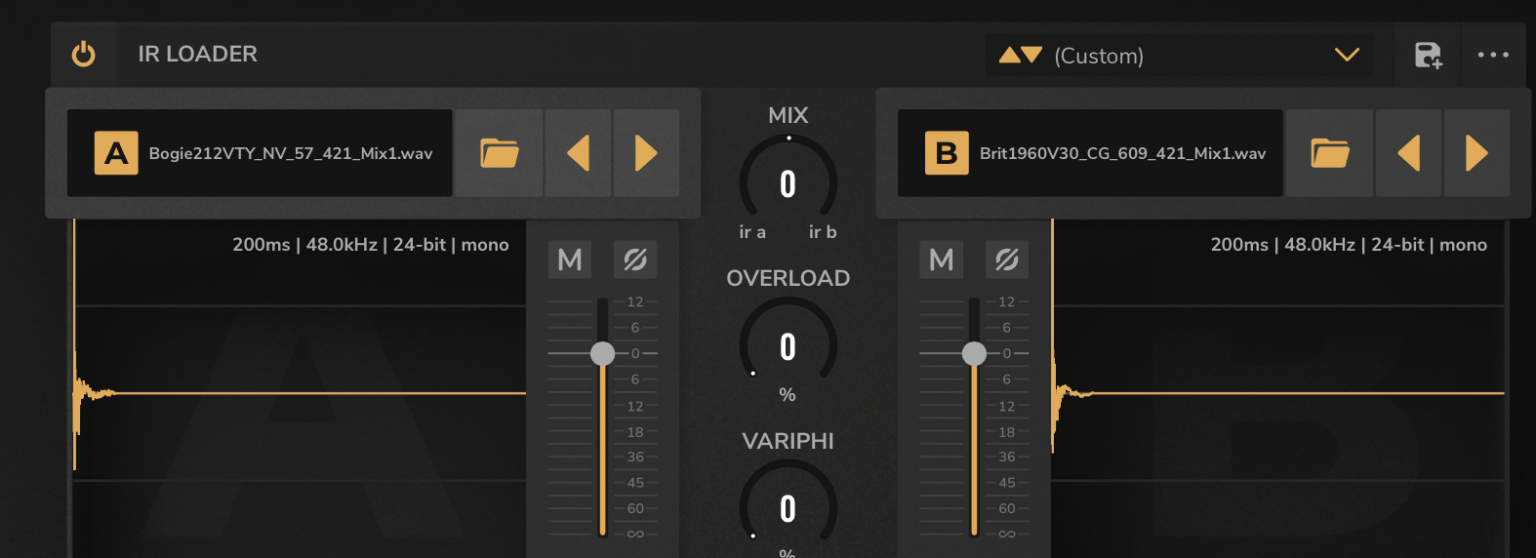
The loader dedicated to Two-Notes cabs is much more sophisticated: it offers the loading and mixing of two microphones from a cab (to be chosen from the 8 microphones available for a given cab), microphones of which you can adjust the position and distance. We keep the possibility of positioning the microphones on the back of the cab, as in the previous Wall of Sound software.
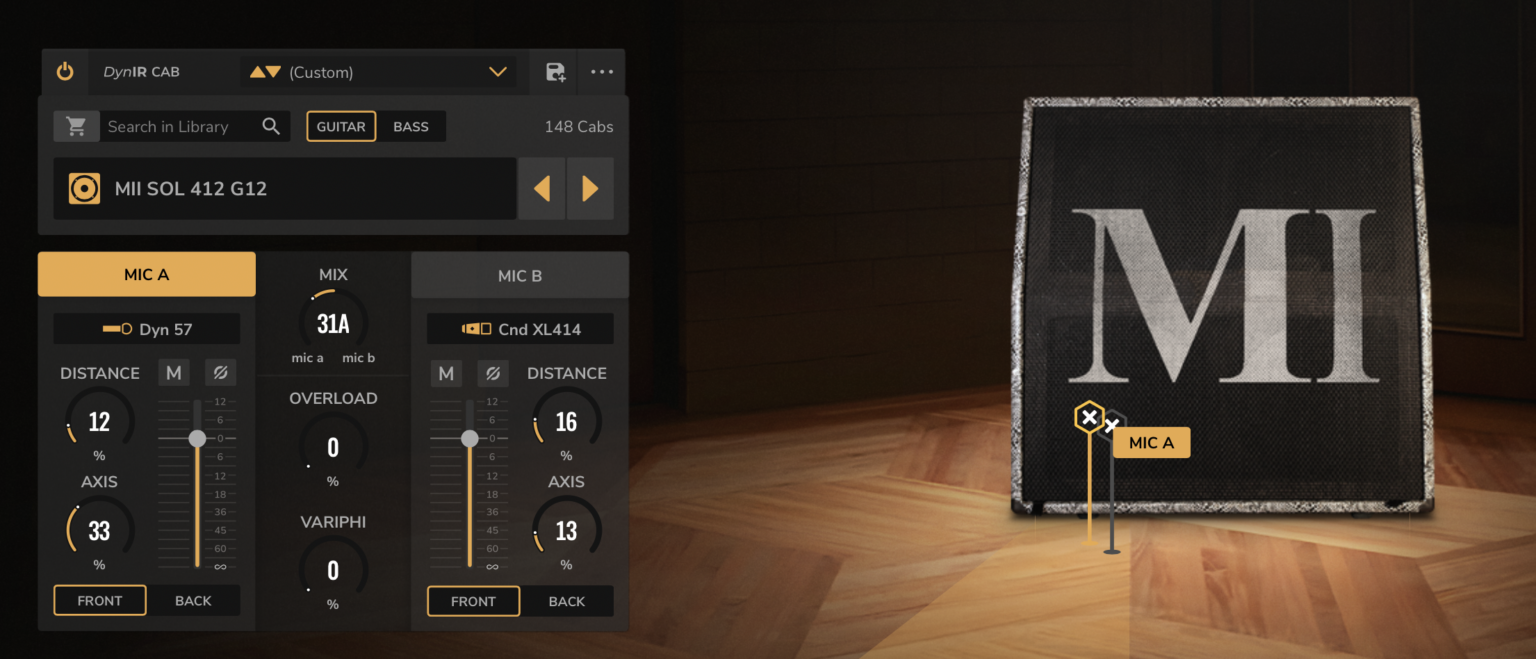
This component gives you access to Two-Notes cabinets, whose quality is widely recognized and whose reputation is well established. You can select a cab for audition from all the cabs in the catalog (you will simply need to be connected to the Internet to do so): then you can choose to buy the cabs that suit you, after auditioning and testing them in your context…
15 virtual cabs in Two Notes format are now included (since version 1.6), including different models of 4*12, 2*12 and 1*12: you can check the list on this link: https://www.two-notes.com/en/whats-included-with-genome/. Genome comes also with a small selection of standard IRs, installed with the product.
CODEX
In addition to the workflow and the completely redesigned interface, CODEX is – in my opinion – the main innovation and one of Genome’s major assets: CODEX is an amp model loader supporting 3 formats: NAM (Neural Amp Modeler), AIDA-X and Proteus/Guitar ML. These three open-source and free solutions are based on Machine Learning techniques and allow the creation of models. These are similar approaches to those of Tonex from IK Multimedia – if you know this solution – and which are also similar to those of Kemper and Neural DSP for the Quad Cortex in the sense that the NAM/AIDA-X/Proteus models behave in the end like profiles reproducing the behavior and sound signature of the amps and/or captured sound chains. Note that NAM is certainly the most popular and the most developed in terms of adoption and number of models at this stage.
A NAM/AIDA-X/Proteus model can reproduce an amp, a preamp only, a pedal or a “full stack” of the pedal-amp-cab-microphone type. And where it becomes really interesting is that the communities around these solutions have already made thousands of models available. If you want to know more, check out tonehunt.org which has become the reference site for sharing these models.
Knowing that these three solutions have free loaders (in the form of plugins for DAW), what is the point of doing the same thing in a commercial plugin ? Well, in my opinion, Genome/CODEX offers several very interesting elements… First of all, the free NAM and AIDA-X loaders are limited to very basic features : loading a model, loading an IR and a generic tone-stack. To obtain more realistic and more usable sounds, you will generally need boosts or overdrives, equalization, modulation effects, reverbs and other delays… in short, a more complete chain… And Genome’s proposal with CODEX is to provide this complete chain inside a plugin. The second point is -in my opinion- the quality and diversity of the IRs: the most widespread models (and the most successful in my opinion) with NAM and AIDA-X are amp models (capture of preamp + power amp sections). To leverage them, it will be necessary to associate “good” IRs and these will make all the difference in the rendering….: with Genome you can load your favorite IRs but also easily associate the excellent Two-Notes cabs.
Third point, the plugin itself directly supports the 3 formats (and therefore avoids juggling with 3 plugins) and offers a complete set of tools to sculpt and refine the sound of the loaded model :

And we end-up with the following features in a single component:
- the ability to load the NAM/AIDA-X/Proteus model
- an eq applied to the input signal: Neutral/Warm/Bright
- a Tonestack modeled by Two-Notes, in an approach similar to that of Kemper with Liquid Profiling, in order to provide more realistic or appropriate treble/midrange/bass adjustment ranges (vs generic adjustments).
- the positioning the pre-model or post-model Tonestack
- an equalizer with lo-cut and hi-cut
- an enhancer, in addition to the EQ or replacing the EQ
The CODEX therefore allows – by itself – to group together a very complete set of features to configure the sound obtained from the model. New tonestacks have been made available by Two-Notes over the course of Genome updates:

During setup, a small pre-selection of NAM/AIDA-X/Proteus models is installed :
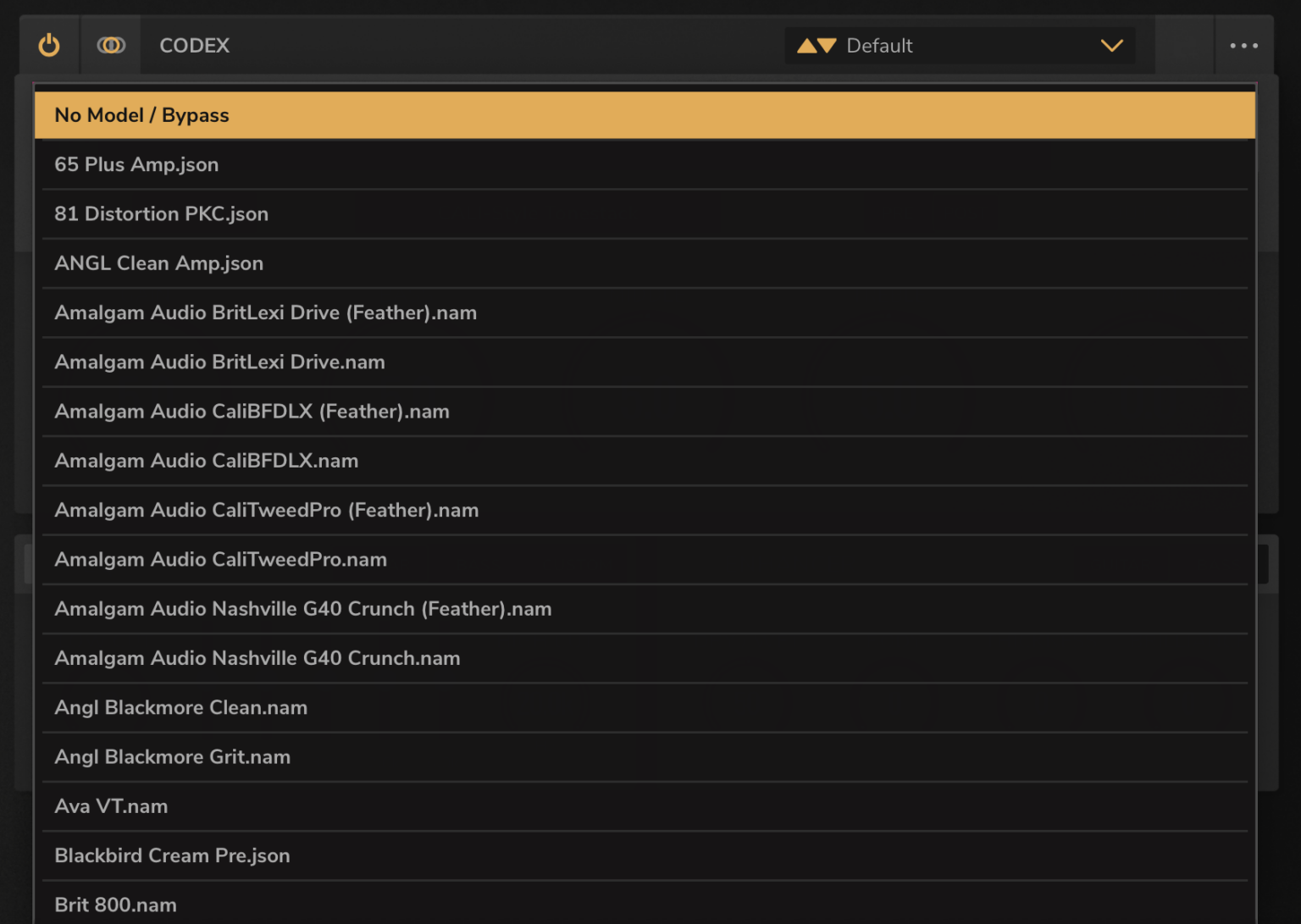
I had the opportunity to test CODEX with ToneHunt models or my own NAM/AIDA-X captures since Genome was released: the rendering is impeccable and the results obtained with these technologies are -in my opinion- excellent. A word of caution, though, as the results depend heavily on the model used, its intrinsic quality (capture done correctly) and its suitability for your expectations and your context (clean, crunch, high-gain, your guitar pickups, etc.)…
Note that the number and quality of models for CODEX are already impressive: thousands of models are available and include “classic” amp and pedal models (Marshall, Mesa, Orange, Engl, Fender, …) but also more exotic models (Driftwood, Dumble …).
Note: you will find 5 types of captures on ToneHunt: amps, pedals, complete rigs ((pedal)+amp+cab+mic), IRs or even processing effects (“outboards”, like preamps, compressors, saturation effects).

With Genome and CODEX, nothing prevents you from stacking several CODEX instances to – for example – create chains like this:
- CODEX: overdrive model
- CODEX: amp model
- DynIR Cab: Cab Two Notes
In terms of CPU requirements, be aware that NAM models are quite CPU-intensive and that AIDA-X models are a little bit lighter. However, a recent PC or MAC will have no trouble loading and running several instances of CODEX and their models, but you may have to increase the size of your processing buffers.
I used below two playlists from my pages dedicated to the NAM and AIDA-X models: these are re-ampings of DI tracks by Lasse Lammert (YouTube channel: https://www.youtube.com/@LasseLammert) with Genome CODEX and using Two-Notes cabs or with my own IRs:
And finally, a third playlist with a small example using a Strandberg neck microphone in coil-split mode. Examples 1 to 4 use an AIDA-X model based on a “BMAN” preamplifier sent to a 6L6 power section, examples 5 and 6 use an AIDA-X model based on a BE-DLX and examples 8, 9 and 10 use a Mystic Edge pedal, also routed to a 6L6 section. The same IR is used on all examples: it is based on a Greyhound speaker mounted in a front-loaded 112 cab. All examples use the reverb included in Genome, in Loft preset, except the last example which uses the StudioA preset.
The signal chain is reproduced below:
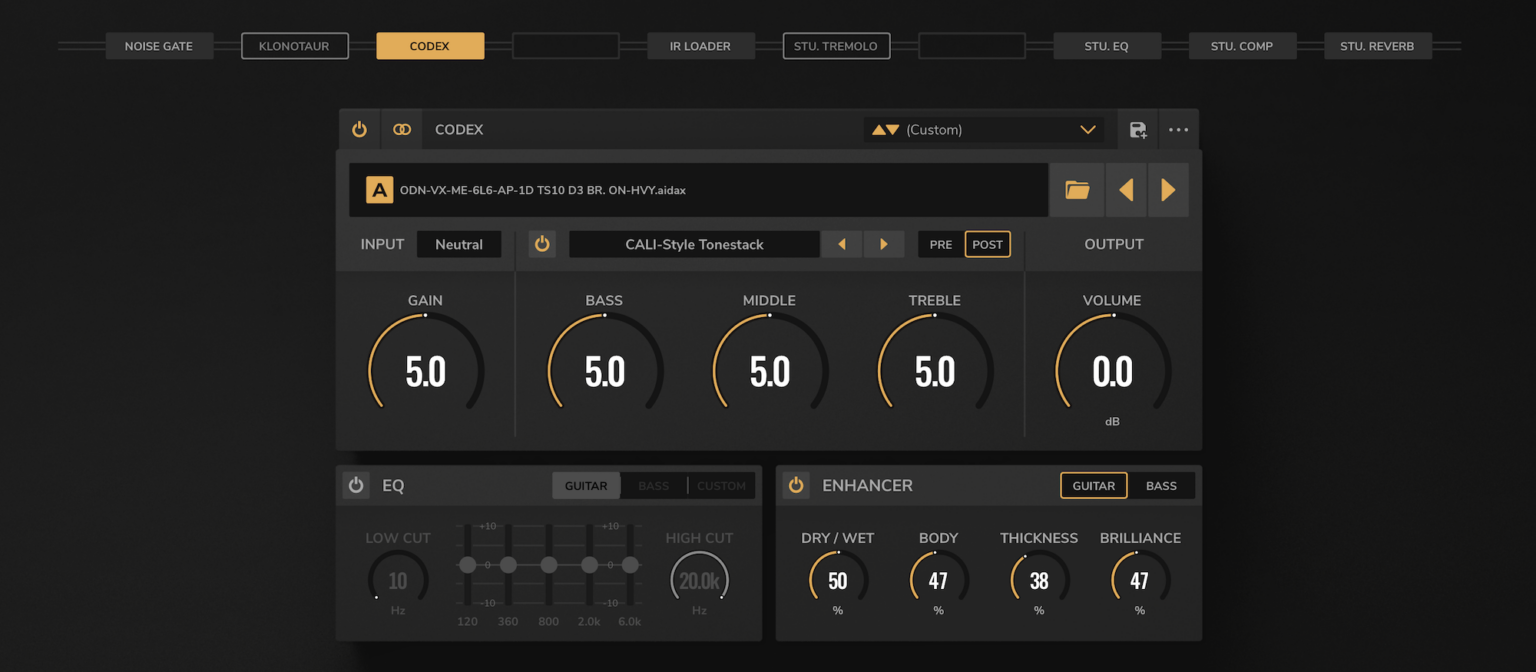
As we can see, the studio EQ and the studio compressor are used, as well as the enhancer of the CODEX module. Examples 2 and 3 use Genome drives (Klon and Raunch Maker), the other examples are either “raw” amp models or models including overdrives directly in the capture.
In the end, the possibilities offered by Genome in terms of re-amping are almost infinite: we have here a solution similar to ToneX or TH-U -which also offers amp captures-, with an already very extensive pool of free models ….
Effects
Genome includes a range of effects, which can be classified into two main categories: classic pedal-type guitar or bass effects (drives, boosts, phaser, etc.) and studio-type effects or processors. On the effects menu, we find:
- dynamic effects: a studio-type compressor (see screenshot below), a noise gate and a volume pedal
- 3 delays (Dupe delay, Studio Delay and Ping Pong)
- 1 reverb: Studio Reverb
- 8 drive or boost pedals: Big Fuzz, D-250 (DOD 250 type), Green Meanies (OD-9 type), Klonotaur (Klon type), Raunch Maker (Blues Breaker type), Ultra Drive (OD-1 type), Vermin (RAT type) and Saber (a clean boost with tone control)
- 3 equalizers: 1 fixed-band for guitar, 1 fixed-band for bass and a very complete parametric studio equalizer (up to 16 bands), with low-cut, high-cut, Notch, slope selection for low-cut and high-cut, whose ergonomics and display are reminiscent of FabFilter’s flagship equalizer.
- Enhancer: 1 enhancer (with 4 parameters Body/Thickness/Dry-Wet/Brillance), 1 exciter (2 parameters: low and high)
- Wah: 1 WahBaby
- Modulation: Studio Chorus, Studio Flanger, Studio Tremolo, Studio Vibrato, Studio Phaser, 9-PHASE (pedal type phaser), and Analog Bass Chorus (pedal type).
- Stereo Width: 1 Twin Tracker (doubler with balance controls and precision of the doubled signal).
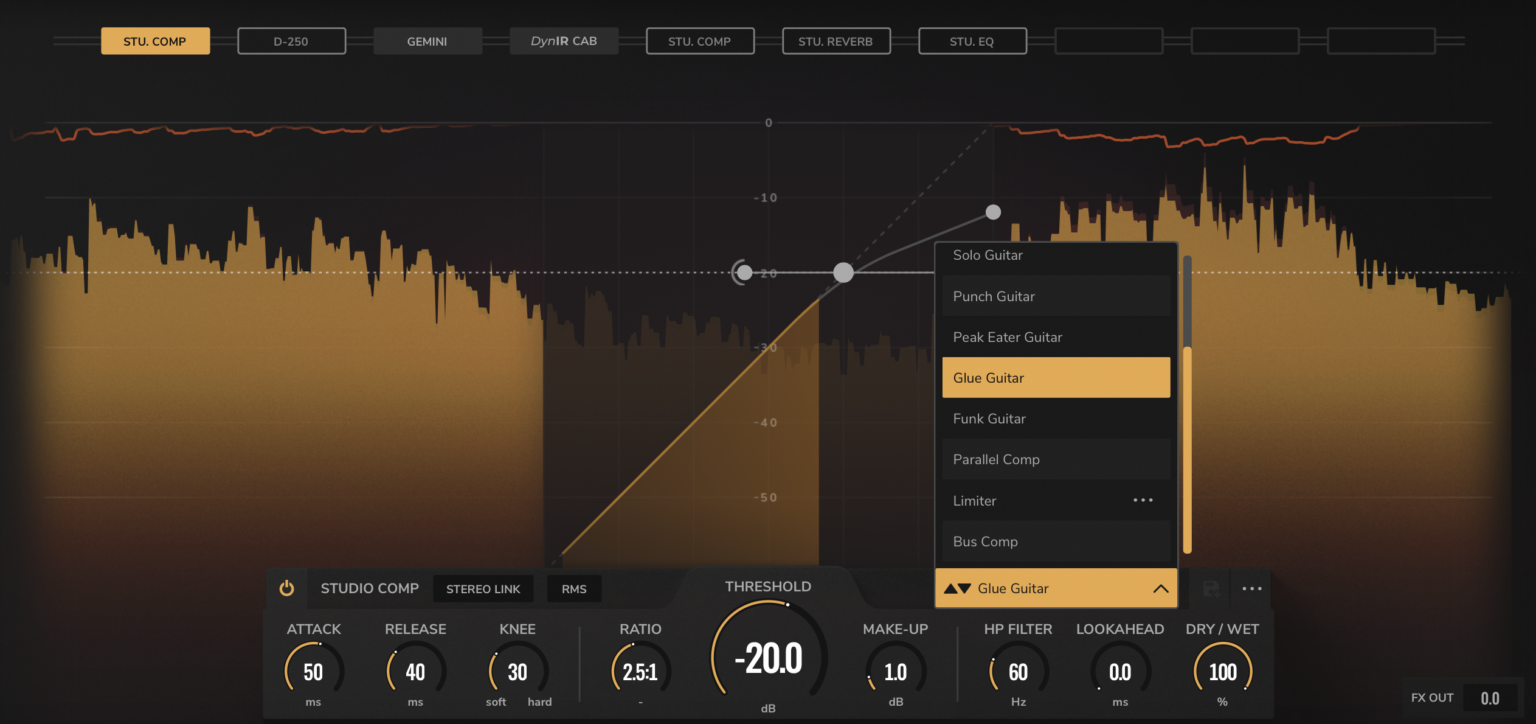
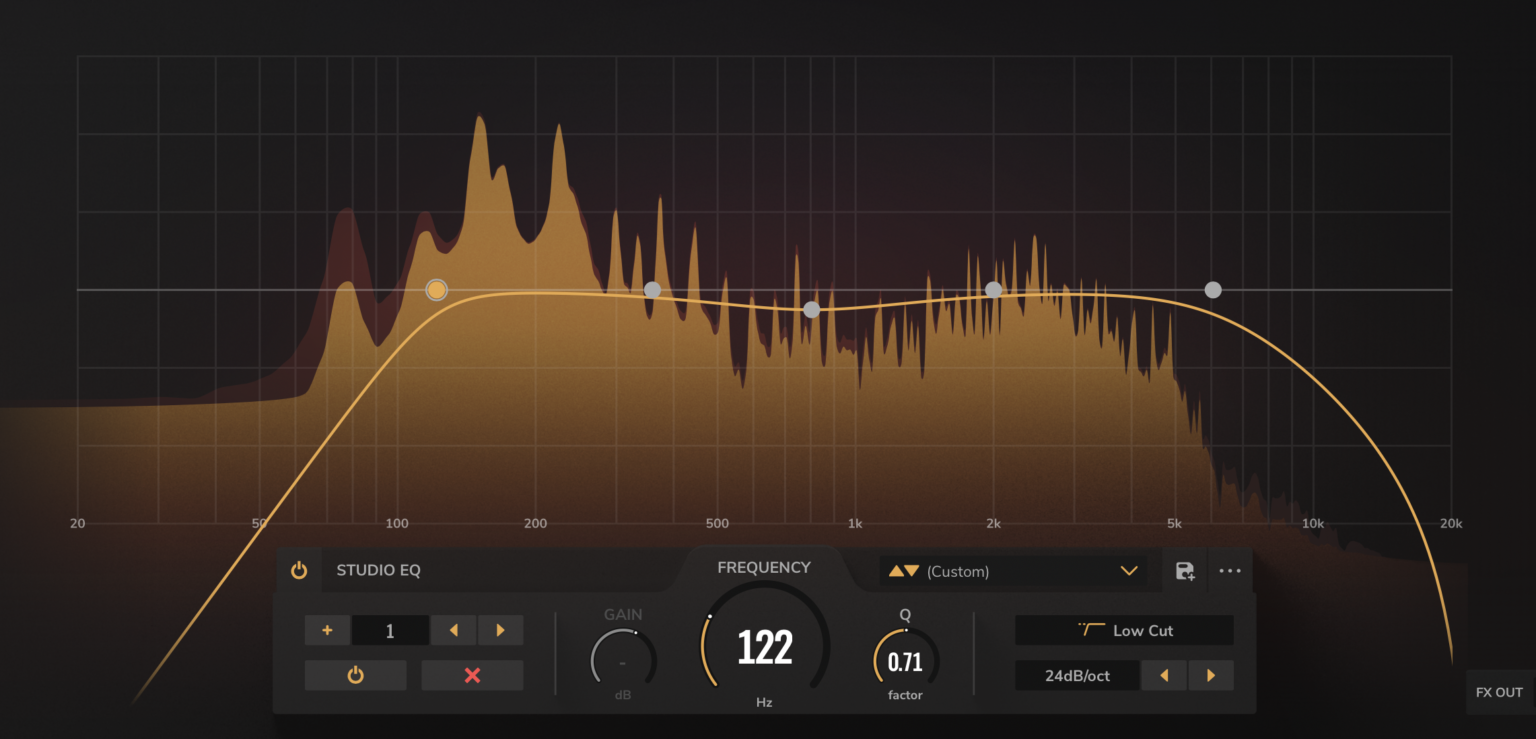
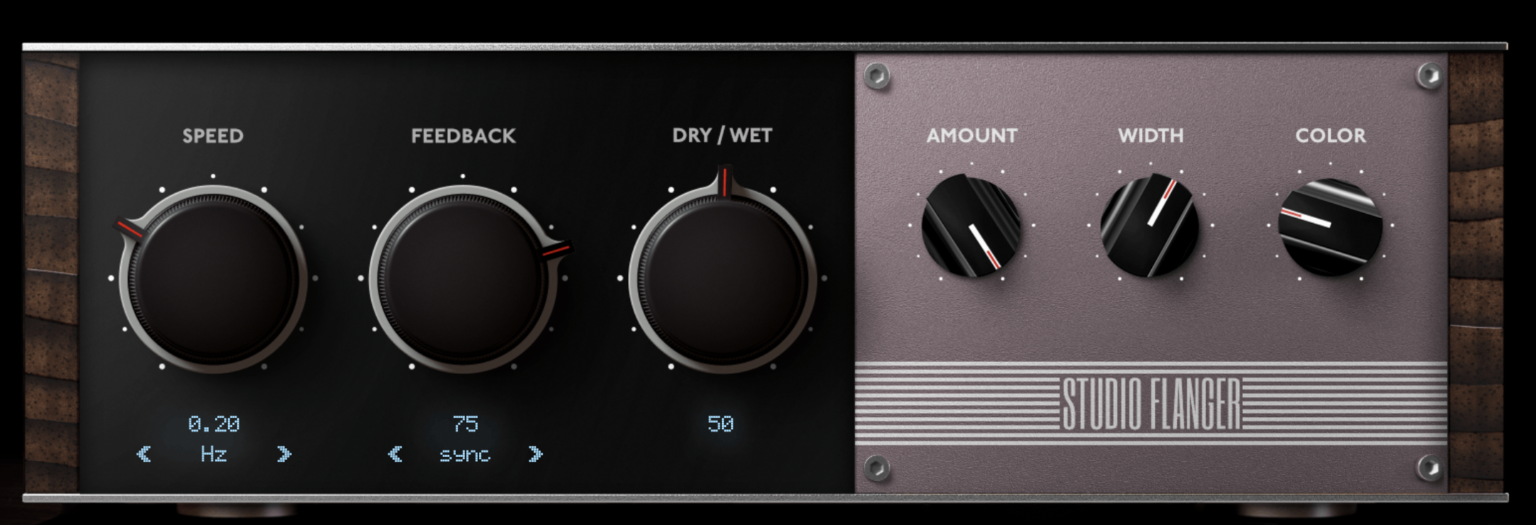
The effects are globally of good quality, without being exceptional in their rendering or diversity (a Line6 Helix Native or a TH-U offer more varied and advanced effects on reverbs, delays and modulations as standard). Special mention for the drives which give very good results (I particularly used the Green Meanies, the D-250 and the Raunch Maker for crunch sounds or to boost high-gain models), for the EQ Studio, very handy and very effective especially for the hi-cut and lo-cut and also for the two enhancers which give impressive results easily and quickly. These last two effects are -in my opinion- a very big plus for sculpting the sound you want to obtain: you can see them as advanced resonance and presence controls, which allow you to very simply and very quickly shape the desired sound….
Additional premium effects are also available for purchase, for more rendering options..…:
- TetraVerb: spring reverb
- Spring 63: spring reverb
- AstroRepeater: tape delay
- Dupe Delay Pro: BBD type delay

The preset system
Two levels of presets are available: the main presets that represent the complete Rig (lanes, blocks and their settings). These presets can be exported / imported and you can also exchange presets on a community site managed by Two-Notes: https://exchange.two-notes.com/genome
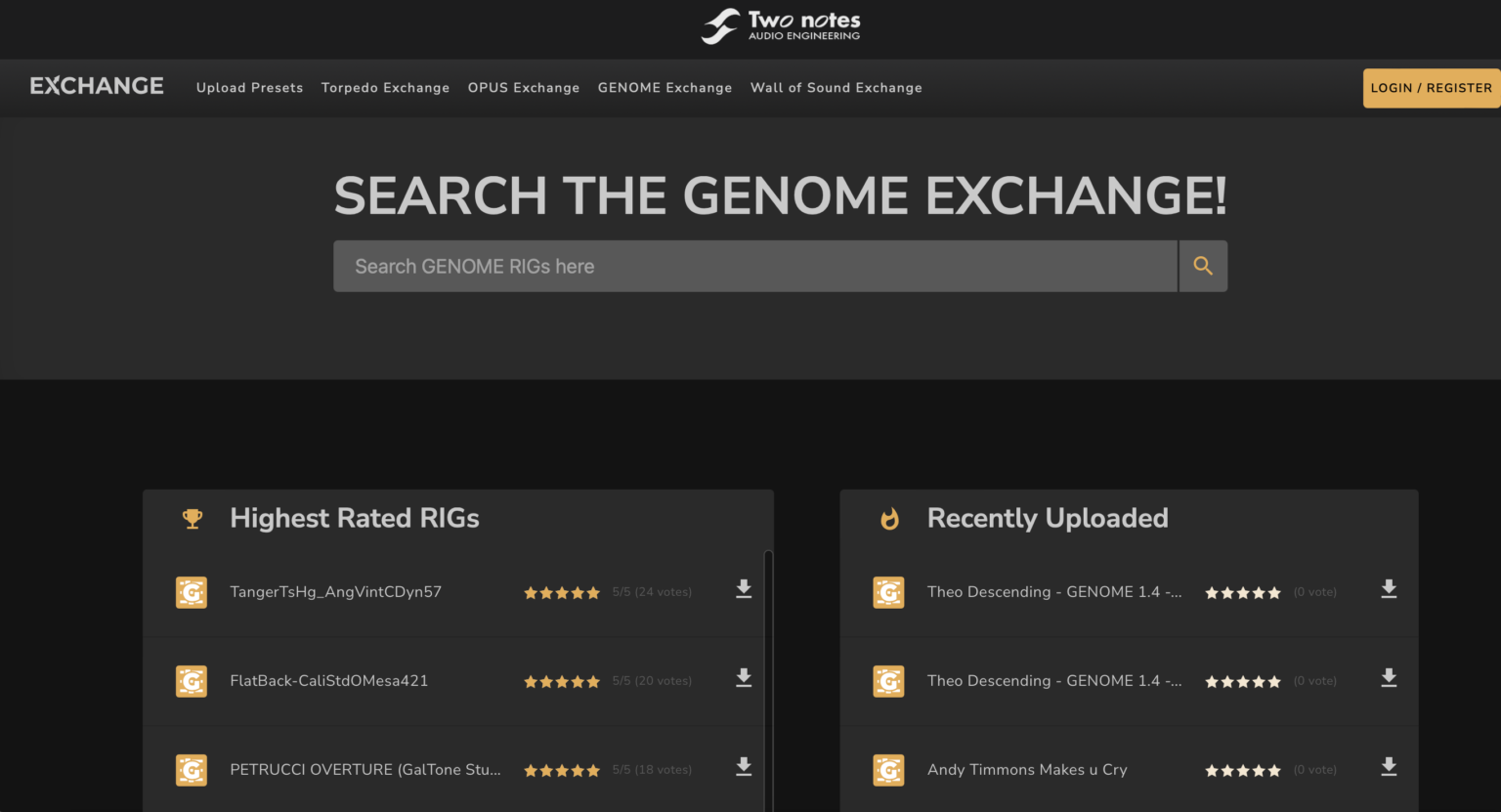
Each component also offers individual presets (EQ presets, compressor presets, amp presets, pedal presets, etc.) that you can enrich by adding your own user presets… This is a good idea and can be very useful for recalling your favorite settings.
Below, the presets on the OD Green Meanies:
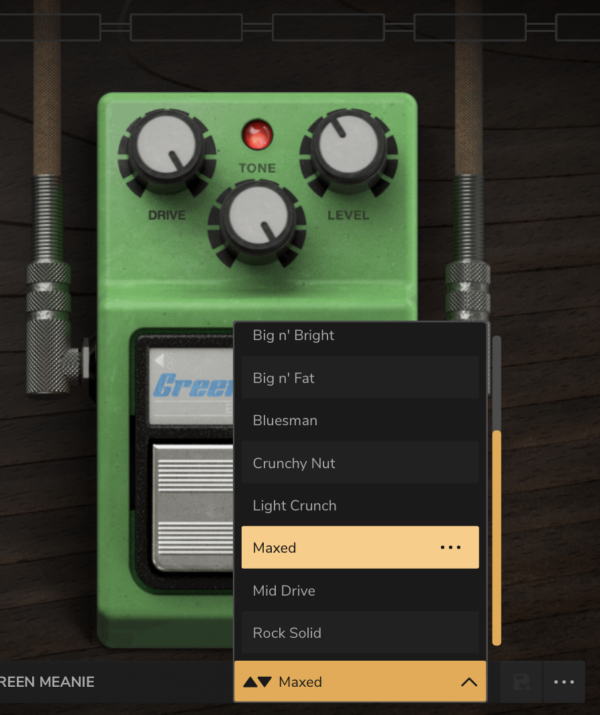
Usage scenarios
To finish this review, I provide a short summary of the possible usage scenarios with this plugin:
- Full re-amping: you can infinitely “re-amp” your guitar DI tracks with a huge number of sound possibilities via the TSM/NAM/AIDA-X/Proteus models and the possible associations with your collection of IRs or Two Notes cabs.
- Use with pedals or preamplifiers (Synergy) or multi-effects (Helix, Ampero, …): the plugin will provide you with the entire Two-Notes IR/Cab part and the post-processing and can also provide you with the power amplification part (to be positioned rather at the beginning of the chain in this type of scenario)
- Use with an amp and a load box: the plugin will provide you with the cab part and the post-processing (scenario similar to the standard use case of Wall-Of-Sound).
- Use in addition to other guitar plugins, possibly for the Cab part (with the possibility of using your DynIRs Two Notes speakers) and all the shaping, EQ and compression processing….
And of course, with recent PC or MAC hardware and a sound card with low latency, you can practice your guitar or bass instrument live.
Conclusion
Genome is now positioned as a real “console strip” dedicated to the production of guitar sounds and is aimed at both amateur guitarists wishing to record themselves and more experienced sound engineers or “producer” guitarists who wish to access an almost infinite palette of sounds and advanced processing options to sculpt their sound. More than a redesign of Wall Of Sound, it is a complete solution and it is – according to me – a successful first step into the world of plugins and modeling. Although facing many established competitors (Tonex/Amplitube, Overloud’s TH-U or Helix Native – modeling only – to name a few), the solution proposed by Two-Notes already has a very solid base of features for a very contained and very reasonable price and is destined to expand and enrich itself… Do not hesitate to check by yourself as a trial version is available on the Two-Notes website (link to the product page below).
Resources:
- Two Notes product page: https://www.two-notes.com/en/genome/
- AIDA-X Overdriven.fr page: https://overdriven.fr/overdriven/index.php/aida-x-models/
- NAM Overdriven.fr page: https://overdriven.fr/overdriven/index.php/nam-models/
- NAM Review : https://overdriven.fr/overdriven/index.php/2023/05/25/nam-0-7-3-review/
Change log
- 2025/01/05 : creation
- 2025/01/16 : edits
- 2025/01/19 : edits
- 2025/02/05 : edits
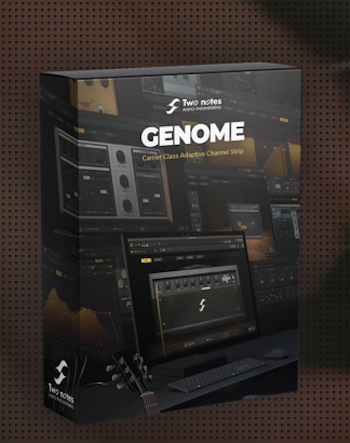
Leave a Reply